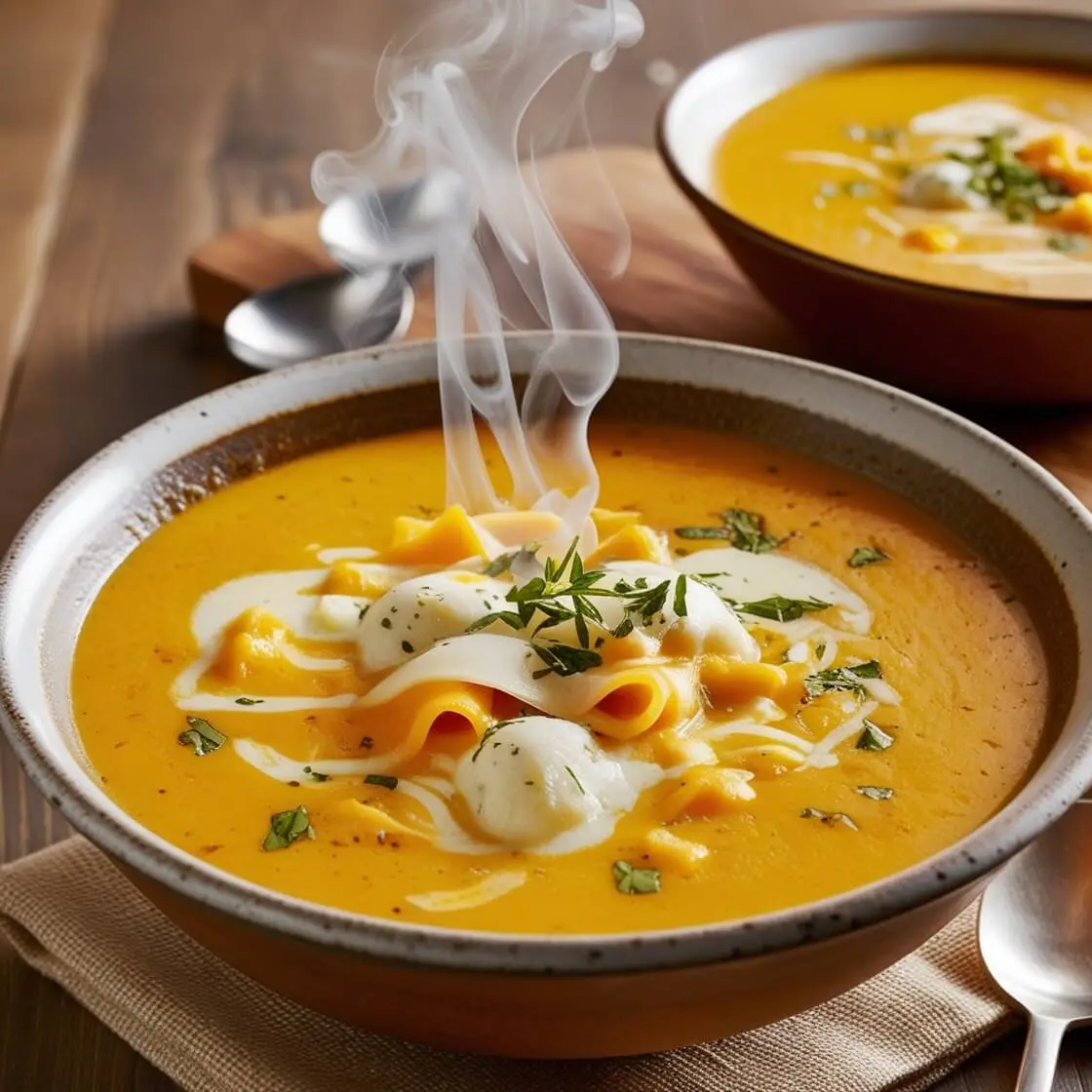Introduction
Cheese can elevate a simple soup into a comforting and flavorful meal. Whether it’s the rich creaminess of cheddar in broccoli soup or the nutty depth of Gruyère in French onion soup, cheese adds a special touch. But with so many options available, how do you choose the best cheese for your soup? This guide explores different cheeses and how to select the right one to achieve the perfect balance of flavor, texture, and consistency in your soup.
Why Cheese is Essential for Perfect Soup Flavors and Texture
Cheese Adds Creaminess and Texture to Soup
One of the most important roles cheese plays in soups is its ability to add creaminess and smooth texture. When melted, cheese enriches the soup, making it thicker and more indulgent. For creamy soups like broccoli cheddar or potato soup, cheese is the key to achieving that velvety consistency. It not only contributes to a luxurious texture but also helps bind the ingredients together, making the soup more satisfying to eat.
In addition, cheese has the ability to soften the sharpness of certain ingredients, like vinegar or acid, and mellow out the flavors. This makes it especially valuable in soups with bold or tangy components, providing a perfect balance.
Enhancing Soup Flavor with the Best Cheese Choices
Choosing the right cheese also influences the overall flavor profile of the soup. Different cheeses bring unique tastes to the table. Cheddar, for instance, is perfect for adding a sharp, tangy flavor that cuts through rich, creamy bases like in potato soup. Meanwhile, Gruyère’s mild yet nutty notes can add complexity to French onion soup.
When selecting cheese for soup, it’s essential to consider how the cheese will interact with the other ingredients. Some cheeses offer a subtle flavor while others provide a bolder kick. Ultimately, the goal is to enhance the soup’s flavor, creating a harmonious balance between all the ingredients.
Cheese Improves the Aesthetic Appeal of Soup
Aside from flavor and texture, cheese improves the visual appeal of soups. Whether it’s the golden, bubbly top of a French onion soup or the creamy swirl of cheddar in a bowl of potato soup, cheese adds a layer of beauty to your dish. The way it melts and blends into the soup can be just as enticing as the taste itself. Cheese also adds contrast and color, making the soup look inviting and appetizing.
What Makes Cheese the Best Ingredient for Soup?
Melting Qualities of the Best Cheese for Soup
When it comes to cheese in soup, melting properties are crucial. Some cheeses melt beautifully into soups, creating that rich, velvety texture, while others hold their shape and add texture. The best cheeses for soup should melt smoothly without becoming greasy or clumpy. For example, mozzarella, Gruyère, and fontina are great choices for their smooth melting characteristics. These cheeses blend seamlessly into the soup, creating a creamy consistency.
On the other hand, cheeses like Parmesan and Pecorino are harder and don’t melt as easily. These cheeses are best used grated and added at the end of cooking or used as a garnish to sprinkle on top of the soup. While they don’t melt into the soup, they enhance the flavor with their sharp, tangy taste.
Flavor Balance: Choosing the Right Cheese for Your Soup
When choosing cheese for soup, it’s important to find one that complements the other flavors without overpowering them. A sharp cheese like cheddar or blue cheese can add a bold flavor, but you’ll want to ensure it balances with the soup’s overall taste. Milder cheeses like mozzarella or ricotta add creaminess without competing with the other ingredients.
To achieve the best flavor balance, consider the type of soup you’re making. For example, in a soup with earthy vegetables, such as mushrooms or leeks, a soft cheese like brie or Gruyère enhances the natural sweetness of the vegetables. For heartier soups, like chili or potato, a strong cheese like cheddar can provide the right contrast.
Best Cheese Varieties to Enhance Your Soup
Cheddar: A Classic Choice for Hearty Soups
Cheddar cheese is one of the most popular and versatile choices for soups. It’s rich, sharp, and melts beautifully into a creamy base, making it perfect for hearty soups like broccoli cheddar, potato, and cauliflower soups. The distinct flavor of cheddar adds complexity to the soup, while its smooth texture enhances the creaminess.
While cheddar is an excellent choice for many types of soup, it’s important to note that there are different varieties, ranging from mild to extra sharp. A mild cheddar is best for smooth, creamy soups, while an extra sharp cheddar can add a tangy punch to heartier, more robust dishes.
Gruyère: Best for French Onion Soup and More
Gruyère is a Swiss cheese known for its nutty, sweet flavor. It’s a top choice for French onion soup, where it creates a perfectly melted, golden-brown crust on top when broiled. Gruyère’s ability to melt smoothly into the soup adds depth to the flavor, complementing the caramelized onions and savory broth. It can also be used in potato soup or any other creamy soup to add richness.
Gruyère pairs well with other cheeses like cheddar and Parmesan, allowing you to create a blend that suits your personal taste. The versatility of Gruyère makes it a favorite among chefs and home cooks alike.
Mozzarella: Perfect for Stretchy Soups
If you’re looking for a cheese that stretches and pulls, mozzarella is the ideal choice. Its mild, milky flavor and gooey texture make it the perfect addition to lighter soups like tomato or vegetable minestrone. Mozzarella creates a delightful stretchy effect, adding fun and texture to the soup.
Because mozzarella has a mild flavor, it’s best used in soups with fresh ingredients, such as tomatoes, zucchini, and basil. The cheese’s delicate taste won’t overpower the other flavors but will instead enhance them.
Parmesan: A Flavor Enhancer in Soups
Parmesan is a hard, aged cheese that doesn’t melt easily, but it’s an excellent addition to many soups. Its sharp, nutty flavor adds a punch to vegetable broths, chicken soups, or creamy potato soups. The key to using Parmesan is to grate it finely so that it can be evenly distributed throughout the soup, providing a burst of flavor in every spoonful.
Parmesan works well when sprinkled on top of soups like Italian wedding soup, where it adds both flavor and texture. It’s also great in a soup made with beans, legumes, or lentils, where it enhances the earthy flavors.
Blue Cheese: Best for Bold, Flavorful Soups
Blue cheese isn’t for everyone, but for those who enjoy bold flavors, it’s an exciting choice for soups. Its sharp, tangy taste works well in earthy, hearty soups like mushroom or cauliflower soups. Blue cheese adds a punch of flavor that cuts through the richness of the soup, creating a complex and satisfying dish.
If you’re new to blue cheese, start with a small amount and gradually add more until you find the right balance for your soup.
Tips for Adding the Best Cheese to Your Soups
Grate or Shred the Cheese for Smooth Melting
Grating or shredding cheese ensures that it melts smoothly into your soup. Large chunks or thick slices can create uneven melting, resulting in clumps or a greasy texture. By grating the cheese, you allow it to integrate more easily, making the soup creamier and more cohesive.
Add Cheese Slowly to Achieve a Creamy Consistency
When adding cheese to your soup, do so slowly and stir constantly. This ensures the cheese melts evenly without clumping. It’s also a good idea to lower the heat when adding cheese, as high temperatures can cause the cheese to separate or curdle.
Try Different Cheese Blends for Unique Flavors
Combining different cheeses allows you to create a unique flavor profile for your soup. A blend of cheddar and mozzarella, for example, will give you both sharp flavor and smooth creaminess. Gruyère and Parmesan make a great combination for French onion soup, offering nuttiness and richness. Experiment with different blends to find the perfect flavor balance.
FAQs
1. Can I use any cheese for soup?
Not all cheeses are suitable for soups. The best cheese for soup is one that melts smoothly and enhances the flavor without overpowering it. Cheddar, Gruyère, mozzarella, and Parmesan are popular choices, depending on the type of soup.
2. What cheese melts best for soup?
Cheeses with high moisture content, like mozzarella, Gruyère, and Fontina, melt the best in soups, creating a smooth, creamy texture. Cheddar also melts well but can become a bit stringy if not handled properly.
3. Can I mix different cheeses in soup?
Yes, mixing different cheeses can create a more complex flavor profile. A combination of sharp cheddar and creamy mozzarella is a great combination, as is mixing Gruyère with Parmesan for added depth.
4. How can I prevent cheese from clumping in my soup?
To prevent cheese from clumping, grate or shred the cheese before adding it to the soup. Add it gradually and stir constantly. Avoid adding cheese to boiling hot soup to ensure it melts smoothly.
5. Can I use cream cheese in soup?
Yes, cream cheese works well in soups where you want a smooth, rich texture. It adds creaminess without overpowering the flavor. It’s especially good in creamy soups like chicken or potato soup.
Conclusion
The right cheese can truly transform your soup into a rich, flavorful, and comforting meal. Whether you’re making a creamy broccoli soup or a savory French onion soup, choosing the best cheese will elevate the dish, making it more satisfying and enjoyable. From the sharp tang of cheddar to the smooth melt of mozzarella, there are plenty of cheeses to experiment with, each adding its unique flavor and texture.
Don’t be afraid to mix different cheeses to find the perfect combination for your soup. For instance, blending cheddar with mozzarella can provide both sharpness and creaminess, while Gruyère and Parmesan bring depth and nuttiness. The possibilities are endless, and by trying different options, you can create a personalized, delicious soup every time.
Ultimately, with the right cheese, every soup becomes an irresistible, comforting bowl of goodness. By choosing wisely and experimenting with flavors, your soups will be transformed into something extraordinary and satisfying for you and your guests.

